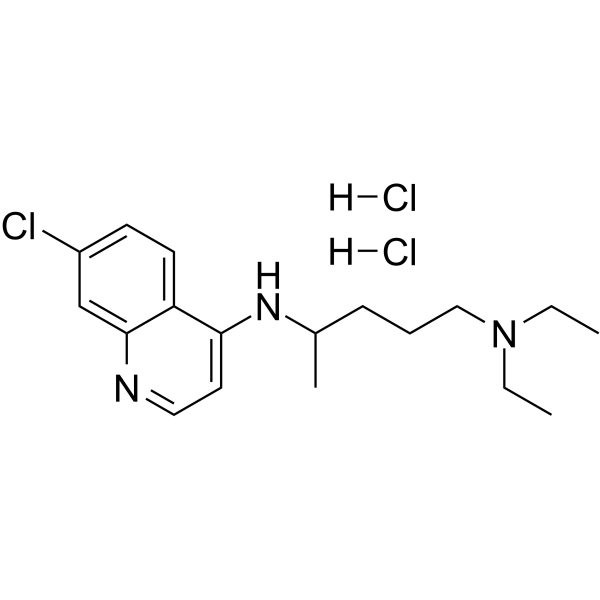上海金畔生物科技有限公司为生命科学和医药研发人员提供生物活性分子抑制剂、激动剂、特异性抑制剂、化合物库、重组蛋白,专注于信号通路和疾病研究领域。
Chloroquine dihydrochloride
Chloroquine dihydrochloride 是一种广泛用于疟疾和类风湿性关节炎的抗疟疾和抗炎剂。Chloroquine dihydrochloride 是autophagy 和toll-like receptors (TLRs) 的抑制剂。Chloroquine dihydrochloride 有效抑制 SARS-CoV-2 (COVID-19) 感染 (EC50=1.13 μM)。

Chloroquine dihydrochloride Chemical Structure
CAS No. : 3545-67-3
| 规格 | 是否有货 | ||
|---|---|---|---|
| 100 mg | 询价 | ||
| 250 mg | 询价 | ||
| 500 mg | 询价 |
* Please select Quantity before adding items.
Chloroquine dihydrochloride 的其他形式现货产品:
| 生物活性 |
Chloroquine dihydrochloride is an antimalarial and anti-inflammatory agent widely used to treat malaria and rheumatoid arthritis. Chloroquine dihydrochloride is an autophagy and toll-like receptors (TLRs) inhibitor. Chloroquine dihydrochloride is highly effective in the control of SARS-CoV-2 (COVID-19) infection in vitro (EC50=1.13 μM)[1][2][3][4]. |
||||
|---|---|---|---|---|---|
| IC50 & Target |
|
||||
| 体外研究 (In Vitro) |
Chloroquine dihydrochloride (20 μM) inhibits IL-12p70 release and reduces Th1-priming capacity of activated human monocyte-derived Langerhans-like cells (MoLC). Chloroquine dihydrochloride (20 μM) enhances IL-1–induced IL-23 secretion in MoLC and subsequently increases IL-17A release by primed CD4+ T cells[1]. Chloroquine dihydrochloride (25 μM) suppresses MMP-9 mRNA expression in normoxia and hypoxia in parental MDA-MB-231 cells. Chloroquine dihydrochloride has cell-, dose- and hypoxia-dependent effects on MMP-2, MMP-9 and MMP-13 mRNA expression[2]. TLR7 and TLR9 inhibition using IRS-954 or Chloroquine dihydrochloride significantly reduces HuH7 cell proliferation in vitro[3]. Shanghai Jinpan Biotech Co Ltd has not independently confirmed the accuracy of these methods. They are for reference only. |
||||
| 体内研究 (In Vivo) |
Chloroquine dihydrochloride (80 mg/kg, i.p.) does not prevent the growth of the triple-negative MDA-MB-231 cells with high or low TLR9 expression levels in the orthotopic mouse model[2]. Shanghai Jinpan Biotech Co Ltd has not independently confirmed the accuracy of these methods. They are for reference only. |
||||
| Clinical Trial |
|
||||
| 分子量 |
392.79 |
||||
| Formula |
C18H28Cl3N3 |
||||
| CAS 号 |
3545-67-3 |
||||
| 运输条件 |
Room temperature in continental US; may vary elsewhere. |
||||
| 储存方式 |
Please store the product under the recommended conditions in the Certificate of Analysis. |
||||
| 参考文献 |
|
所有产品仅用作科学研究或药证申报,我们不为任何个人用途提供产品和服务
